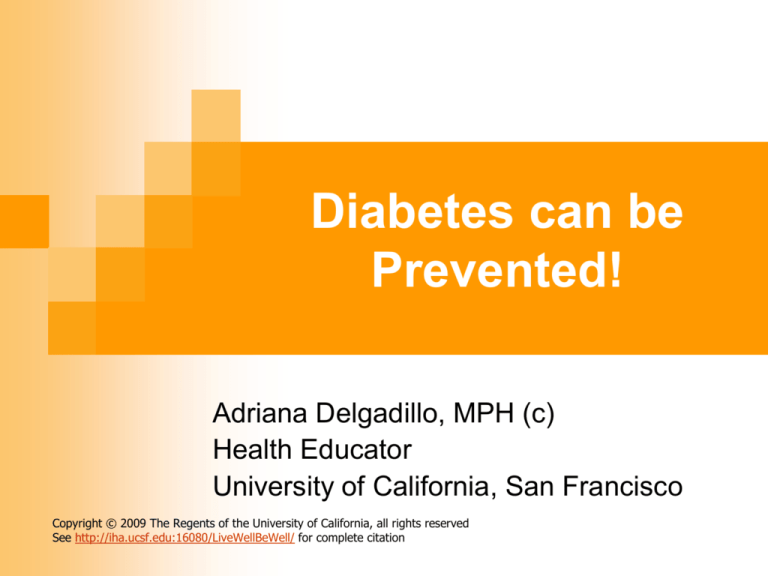
Diabetes can be
Prevented!
Adriana Delgadillo, MPH (c)
Health Educator
University of California, San Francisco
Copyright © 2009 The Regents of the University of California, all rights reserved
See http://iha.ucsf.edu:16080/LiveWellBeWell/ for complete citation
Today we are going to talk about:
What
is diabetes?
How does blood sugar work?
What is type 2 diabetes?
What are the symptoms?
How diabetes affects the body?
Who is at risk of getting diabetes?
What is pre-diabetes?
How can I prevent diabetes?
2
How many people have diabetes?
20.8 million people in the U.S. have diabetes
1/3 or the people who have diabetes don’t know it
= 1 million people
3
What is diabetes?
Diabetes means that your blood sugar (glucose)
is too high
Your blood always has some sugar in it because
the body needs sugar for energy
But too much sugar in the blood can cause
damage to your health
Diabetes can be controlled but not cured
4
How does sugar work in your body?
Step 1:
The food you eat turns into
sugar in your stomach.
Step 2:
Your blood carries the sugar
to your body cells.
Stomach
Glucose
5
Step 3:
The pancreas is in charge of releasing insulin.
Insulin helps sugar enter
body cells.
If your body doesn’t make enough insulin or the
insulin doesn’t work the way it should, the sugar
can’t go into the cells making your blood sugar
go up.
6
Type 2 Diabetes
The pancreas doesn’t make enough insulin
The insulin doesn’t work the way it should
90% of diabetes cases are type 2
7
What are the symptoms?
Always tired
Frequent urination
Always thirsty
Always hungry
Blurred vision
Tingling hands or feet
Wounds that don’t heal
Sudden weight loss
8
Diabetes can damage…
High blood sugar levels over time
can affect blood flow
This can cause heart attacks,
strokes and high blood pressure
Your heart
Your eyes
High blood sugar levels can
damage the small blood vessels
in the back of the eye
This can cause blurred vision and
loss of vision
9
Diabetes can damage…
Blood vessels within the
kidney are affected
Over time, high blood sugar
can damage nerves in the
body
Loss of sensation, pain and
burning sensation in feet
Your kidneys
Your nervous
system
10
Who is at risk for type 2 diabetes?
People who:
Are older than 45
Have a family member with diabetes
Are Latino, African-American, Native-American o
Asian-American
Had diabetes during pregnancy
Are overweight
Have high cholesterol
Have high blood pressure
11
How do I know if I have diabetes?
By doing a fasting
blood test
It can only be
diagnosed by a
doctor
12
What is pre-diabetes?
Blood glucose levels are
higher than normal but not
high enough to be diabetes
Occurs before people develop
type 2 diabetes
At this stage, you can delay
or prevent diabetes
13
You can prevent diabetes!
Eating less fat
Eating more vegetables & fruits
Eating more fiber
14
You can prevent diabetes!
Regular physical activity
Helps your body to use insulin better
Helps maintain weight loss
Walking 30 minutes,
5 days a week, has been
shown to reduce the risk
of getting diabetes
15
Take action today…
If you haven’t eaten in 8 hrs,
take a finger prick test
This will tell you if you are at risk
of getting diabetes
If you are at risk, you may be able to join the
Live Well, Be Well project
16
To conclude…
Diabetes is a serious disease that can cause
serious health problems
It can be prevented
Healthy eating and exercise
can make the difference
Get tested today. Do it for you and your loved
ones
17
For more information about
diabetes…
American Diabetes Association
1-800-DIABETES (1-800-342-2383)
Monday - Friday, 8:30 AM - 8 PM (Eastern Standard Time)
www.diabetes.org
18
Thank
you!
19







